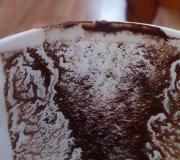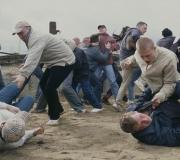Presentation "Teaching literacy (writing) by L.F. Klimanova (UMK "Perspective"). Teaching literacy
Literacy training (writing) by L.F. Klimanova
(UMK "PERSPECTIVE")
KADNAY Irina Vakilevna
primary school teacher
GBOU Secondary School No. 23 named after B.A. Kucher



- The authors of the educational complex “Perspective” are the developers of the Federal State Educational Standard, famous scientists, teachers, and methodologists:
L.F. Klimanova, A.A. Pleshakov, M.Yu. Novitskaya, V.G. Dorofeev and others.


Lyudmila Fedorovna
KLIMANOVA, Ph.D.
author of the “Introduction to Literature” program and a unique system of teaching literacy on a communicative-cognitive basis, which allows you to form elementary ideas about language as the most important means of communication and knowledge of the world around you. It is this system that formed the basis of the new generation of textbooks on teaching literacy, the Russian language and literary reading, which are published within the framework of the Perspective educational complex.

Educational and methodological set “Teaching literacy” (writing) 1st grade authors: L.F. Klimanova, A.V. Abramov

- The literacy course is distinguished by its communicative-cognitive and spiritual-moral orientation.
- The main goal of the course is the active formation of all types of speech activity: the ability to write, read, listen and speak, the development of first-graders’ verbal thinking, the ability to communicate and understand themselves and others.


Workbook “Draw, Think, Tell”
- Designed for use during the preparatory period of learning to read and write.
Working with it, children have the opportunity to draw, paint, hatch, etc., which helps strengthen the fine muscles of the fingers, develop coordination of hand movements when writing and thereby prepare well for writing letters of the Russian alphabet, words and sentences.




Copybooks “My alphabet” (in 2 parts)
They provide examples of printed and written letters, the simplest structural and semantic models of words, include exercises for writing words, sentences and small texts, and form initial spelling skills.













Workbook “Write beautifully”
Serves as a supplement to the textbook “ABC. 1 class". The manual contains exercises for teaching writing skills. By mastering the written word, first-graders simultaneously strengthen calligraphy skills and develop fine motor skills. The material helps students achieve
1st grade meta-subject and subject learning outcomes.

conclusions
- The educational complex reveals in a new way the possibilities of integrating the cognitive and personal development of younger schoolchildren;
- contains tasks of varying degrees of difficulty, giving the opportunity to offer students different options depending on the child’s preparedness;

- tasks are offered in a form that revitalizes interest and activity in cognition and curiosity, while directing activity into the sphere of free creativity;
- The system of tasks helps to develop in schoolchildren logic, imaginative thinking, imagination, intuition, value worldview, and moral position of the individual.


Is your child studying under the UMK Perspective program? We are ready to provide you with a complete set of textbooks and workbooks from grades 1 to 4 that correspond to this system. It doesn’t matter what city in Russia you live in - your set of textbooks will be delivered to you in the fastest and most convenient way!
Stores where textbooks UMK Perspective can be bought at retail, they raise the price quite significantly compared to the original one. But if you buy or order textbooks and workbooks as a set, it costs much less! But we don’t just offer you a set of textbooks - we offer you textbooks and workbooks for the Perspective program for the entire class at a discount, which will have a wholesale price that is 10-15% lower than the market price!
You can review the list and compare the prices listed there with the prices offered in the store. We are sure the difference will amaze you! Add to this the time saved that you would have spent searching for each textbook and workbook.
Lesson summary on teaching reading during literacy training.
Lesson topic: Introducing the consonant sounds [k] and [k’], and the letter K, k.
Program: UMK “Perspective” L. F. Klimanova, S. G. Makeeva “ABC” 1 part
Class: 1 class
Target: Educational: Maintaining new knowledge about the sounds [k] and [k’], their characteristics and the letter K, k; developing the ability to isolate the sounds [k] and [k’] from the stream of speech; the ability to denote the sounds [k] and [k’] with the letter K, k; developing the ability to synthesize the sounds [k] and [k’] with other vowels into syllables; formation of skills to read merger syllables, words, sentences and understand what is read.
Developmental: Development of a child’s personality based on UUD formations that provide the ability to learn:
Reflexive awareness of the boundaries of one’s knowledge and non-knowledge (during repetition);
Formation of universal regulatory actions of self-control and mutual control (checking the design, checking the scheme, intonation);
Formation of the sign-symbolic action of modeling (composing models of the words mole and crayfish);
Educational and information skills (when working on illustrations);
Development of the universal logical action of analysis, synthesis (when analyzing letters, when reading syllables, words and text);
Development of universal communicative actions (when communicating “student - teacher” and “student - student”, when working in a classroom and in a group)
Educational: Forming the ability to enter into educational interaction with the teacher and students; instill an interest in reading, cultivate a love of nature, animals, and work.
Lesson plan:
Organizational moment (welcoming children, checking readiness for the lesson, positive attitude)
Systematization and repetition of previously studied material (vowels and consonants)
Checking the homework (reading in pairs and explaining the meanings of phrases)
Introduction of new material:
Introduction of a new sound:
A) Syllable – sound analysis of the words MOLE, CRAWFISH.
B) Comparison of sounds [k] and [k’]
C) Exercise in hearing sounds [k] and [k’]
D) Story based on the picture (Work in groups)
D) Sound synthesis
Physical education minute
Introduction of a new letter:
Presentation of the new letter K, k as a sign to designate the sounds [k] and [k’]
Looking at a letter
Comparison of a letter with the surrounding world
Letter analysis (composition of the letter K, what elements it consists of, what letters it is similar to and how it differs)
Placing the letter K in a letter ribbon
Reflective-evaluative stage
Linguistic and methodological analysis:What students know: Characteristics of vowels and consonants. Sounds [m] and [m'], [s] and [s'], [n] and [n'], [l] and [l'], [t] and [t'], [a], [o], [u], [i], [s], [e] and the letters denoting them.
What new will you learn: They learn that the sounds [k] and [k’] are denoted by the letter K, k. What difficulties do schoolchildren experience: Isolate the sounds [k] and [k’] from merging syllables, compose a story based on a picture, perform a syllable-sound analysis of words, it is difficult to synthesize the C + G sound.
Equipment:For the teacher: Alphabet, cursive, tape of letters, presentation, circles for models of the words “mole” and “crayfish”, pictures of the words: whale, cat, glass, fry, pomegranate, pictures for a story based on the picture + story plan.
For the student: ABC, cursive, colored pencils, box of letters.
During the classes:
Organizing time :
The bell rang and class began.
And so that everyone can benefit from the lesson,
Get more involved in your work, my friend.
Guys, let's check your readiness for the lesson. You should have the alphabet on your table - put your hand on it, a copybook - put your hand on it, a notebook - put your hand on it, colored pencils - put your hand on them, a box of letters - put your hand on it.
Raise your hand if you don't have any of the things I mentioned.
Guys, today we continue our journey through the country of ABC.
Systematization and repetition of previously studied material :
What is the difference between vowels and consonants? (Vowels are pronounced with the help of the voice, when pronounced by the speech organs there is no obstacle. Consonants are pronounced with the help of the voice and noise or only with the help of noise; when pronounced, the air encounters an obstacle from the speech organs.)
What vowel sounds have we already learned? (We have already studied the vowel sounds a, o, u, i, ы, e)
What consonant sounds have we already learned? (We have already studied the consonant sounds m, s, n, l, t)
What groups are consonant sounds divided into according to softness and hardness? (Consonant sounds are divided into hard and soft according to softness and hardness)
What groups are consonant sounds divided into depending on voice and noise? (Divided into voiced and voiceless)
What voiceless consonants do we already know? (We already know the voiceless consonants s, t)
What voiced consonants have we already studied? (We have already studied the voiced consonants m, n, l)
Guys, what consonant sounds and letters did we learn about in the last lesson? (We got acquainted with the consonant sounds [t] and [t’] and the letter T t)
Checking d/z:
Guys, we’ll check your health and safety now.
Who did not complete the task, raise your hand.
We begin checking the d/z.
You will need to check the reading of words in pairs. For example, a couple Misha and Katya. Misha reads the first line, and at this time Katya watches how Misha reads; if Misha is mistaken, then Katya corrects him. Then Katya reads, and Misha watches her reading.
Do you understand the task? (Yes)
Let's check how you explained the meaning of the phrases.
How did you explain the meaning of the phrase “winter is upon us”? (Winter is very close)
Guys, touch your nose with your hand. Got enough? So the nose is close? Winter is also coming.
How did you explain the meaning of the phrase “cut it on your nose”? (Remember)
Does anyone have a different opinion?
That's right guys, “cut it on your nose” - remember.
Well done, you coped with the problem!
Introduction of new material :
Isolation of sounds [k] and [k’]:
Two pictures are given:
Guys, let's look at the first picture. (3 Slide)
What is shown in the first picture? (Mole).
Let's say the word KPOT.
How many syllables? (One syllable). (PUT YOUR HAND TO YOUR CHIN)
Let's intonate the first sound. (kkkrot)
Hard or soft? (Solid)
Voiceless or voiced? (Deaf)
(HANGING A BLUE CIRCLE)
Let's intonate the second sound. (crrrrot)
Is it a consonant or a vowel? (Consonant)
Hard or soft? (Solid)
Voiceless or voiced? (Voiced)
What circle on the diagram will we designate it with? (Blue) (HANGING A BLUE CIRCLE)
Let's intonate the next sound. (krooot)
(HANGING A RED CIRCLE)
Let's intonate the next sound. (crottt)
Is it a consonant or a vowel? (Consonant)
Hard or soft? (Solid)
Voiceless or voiced? (Deaf)
What circle on the diagram will we designate it with? (Blue) (HANGING A BLUE CIRCLE)
Let's summarize the information we have received about the sound [k]. (Sound [k] consonant, deaf, hard)
Guys, let's look at the second picture. (4 Slides)
What is shown in the second picture? (Crayfish).
How many syllables? (Two syllables). (PUT YOUR HAND TO YOUR CHIN)
Let us create a model of this word.
Let's intonate the first sound. (rrraki)
Is it a consonant or a vowel? (Consonant)
Hard or soft? (Solid)
Voiceless or voiced? (Voiced)
What circle on the diagram will we designate it with? (Blue) (HANGING A BLUE CIRCLE)
Let's intonate the second sound. (raaaki)
Is it a consonant or a vowel? (Vowel)
Shocked or unstressed? (Shock)
What circle on the diagram will we designate it with? (Red) (I HANG UP A RED CIRCLE, I PUT AN EMPHASIS)
Let's intonate the next sound. (rakkki)
Let's characterize this sound. (This is a consonant, soft, dull sound)
What circle on the diagram will we designate it with? (Green) (I HANG A GREEN CIRCLE)
Have we identified all the sounds? (No, not all)
Let's intonate the next sound. (rakiee)
Let's characterize this sound. (This is a vowel, unstressed sound)
What circle on the diagram will we designate it with? (Red) (HANGING A RED CIRCLE)
Now let's check if we have identified all the sounds? (That's it)
Let's summarize the information we have received about the sound [k’]. (Sound [k’] consonant, deaf, soft)
Compare the sounds [k] and [k’]:
What common? (These are consonants, voiceless sounds)
What is the difference? (One hard, one soft sound)
Exercise in hearing the sounds [k] and [k’]:
Find the sounds [k] and [k’] in the words. (I HANG THE PICTURES ON THE BOARD)
Prove that they exist (Guys must intonate this sound). (kkkit, kkkot stakkkan, malkkki).
Do all words have these sounds? (No)
In which word did we not find these sounds? (The word pomegranate does not contain these sounds)
Story from the picture: (Work in groups)
Guys, let's unite into groups (5 groups of 5 people).
In your group, you need to compose a story based on the picture that is shown on your card using words with the sounds [k] and [k’] according to the plan. Once you have completed your story, you will need to choose a student to present a story for your group.
Prove that you used words with these sounds. (WHEN STORYING, THE PICTURE APPEARS ON SLIDE 5 – 9)
Now let's get started with sound synthesis. I will tell you the sounds, and you need to merge them into syllables: k - a (ka), k - y (ku), k'-i (ki), k'- e (ke), k - o (ko) , k'-u (kyu).
Physical education minute:
And now, guys, stand up.
They quickly raised their hands up,
To the sides, forward, backward.
Turned right, left,
They sat down quietly and got back to work.
Getting to know the letters K, k:
The consonant sound [k] and [k’] can be written with a letter, which is called the consonant letter K, k.
Look at the slide. There are two pairs of letters there. One pair is block letters, the other pair is capital letters Kk. (10 Slide. I SHOW THE LETTERS ON THE SLIDE).
One capital, big one. They start a sentence with it, write people's names, animal names, names of cities, countries with a capital letter.
And the other letter is lowercase, small.
We will learn how to write the lowercase letter K in the next lesson.
Let's find this letter in our individual cash registers.
To better remember the outline of the letter K, k, let’s get up from our desks and show this letter.
What elements does the letter K, k consist of? (From slanted lines)
What does the letter K look like in the outside world? (A bird with an open beak; a crocodile has opened its mouth.)
What letters does this letter resemble? (Children’s answers. For the letter F, I)
How is it different from other letters? (Children's answers. Half of the letter Z)
Let's open our ABC on page 86 and look at the picture of the letter at the top of the page. Now make the same letter K using a pair of colored pencils. (I walk through the rows and check how the children completed the task)
In which square do we place the letter K on the letter tape? (We'll put the letter K in the blue box because it's a consonant.)
Top or bottom line? Why to the bottom? (Children's answers. The letter Ks means a dull sound)
Reading syllables, words and text with a new letter:
Guys, let's read the syllables:
ok ok ik (11 Slide)
Let's name the letters.
Let's name the sounds.
We read the syllable.
Let's read the syllables in the ABC on page 86 in the frame:
KA, KO, KU, KY, KI:
Syllable KA: Let's name the letters.
What did we get? (Syllable KA)
Syllable KO: Let's name the letters.
Let's try to combine two sounds.
What did we get? (Syllable KO)
Syllable KU: Let's name the letters.
Let's try to combine two sounds.
What did we get? (Syllable KU)
Syllable KY: Let's name the letters.
Let's try to combine two sounds.
What did we get? (Syllable KY)
Syllable CI: Let's name the letters.
Let's try to combine two sounds.
What did we get? (Syllable KI)
Let's read the words with you (ABC p. 88). We will read the first two columns:
Cat: Let's name the letters. (Cat)
How many syllables? How did you find out? (One syllable, because one vowel o)
Let's name the sounds. ([cat])
What word did you read? (Cat).
Whale: Let's name the letters. (K, i, t)
How many syllables? How did you find out? (One syllable, because one vowel and)
Let's name the sounds. ([k’], [i], [t])
What word did you read? (Whale).
Scythe: Let's name the letters. (K, o, s, a)
How many syllables? How did you find out? (Two syllables, because two vowels are o, a)
Let's name the sounds. ([k], [o], [s], [a],)
What word did you read? (Scythe).
Fox: Let's name the letters. (Fox)
How many syllables? How did you find out? (Two syllables, because there are two vowels and, a)
Let's name the sounds. ([fox],)
We read the first syllable. (whether)
We read the second syllable. (sa)
What word did you read? (Fox).
Varnish: Let's name the letters. (L, a, k)
Let's name the sounds. ([l], [a], [k])
Let's read. (varnish)
Poppy: Let's name the letters. (M, a, k)
How many syllables? How did you find out? (One syllable, because one vowel is a)
Let's name the sounds. ([m], [a], [k])
Let's read. (Poppy)
Enough.
Now guys, let’s read the text (ABC p. 87) (text with tasks).
What do you think this text will be about? (Text about the circus)
Let's read this text with you. Some words hide pictures. As we read, we must reveal which words are hidden in the pictures.
We're on vacation. We're near the circus. There are horses, elephants and a donkey. Elephants are smart. The elephant was giving the dachshund a ride. The clown threw a sausage to the elephant and a carrot to Toto the donkey. The donkey played the drum.
Now let's check how you understood the text:
Who's on vacation? (The guys are on vacation)
Where are the guys? (The guys are near the circus)
Who performs in the circus? (Horses, elephants and a donkey perform in the circus)
What was the elephant doing? (The elephant was giving a ride to the dachshund)
What did the clown throw to the elephant? (The clown threw a sausage to the elephant)
What was the donkey's name? (The donkey's name was Toto)
What did the clown throw to Toto the donkey? (The clown threw a carrot to Toto the donkey)
What was the donkey doing? (Donkey played the drum)
D/Z:
Open ABC page 89 and copybook page 35.
In the copybook on page 35, you will need to color the clown if you wish.
Do you have questions about d/z?
Reflective-evaluative stage:
Guys, did you like the lesson? (Children's answers)
What sounds and letters did we meet today? (Today we became acquainted with the sounds [k] and [k’], and the letter K, k).
What did we repeat? (Consonants and vowels; sounds [t] and [t’], and the letter T, t)
What was difficult? (Children's answers)
How to overcome these difficulties? (Children's answers)
Well done! The lesson is over!




